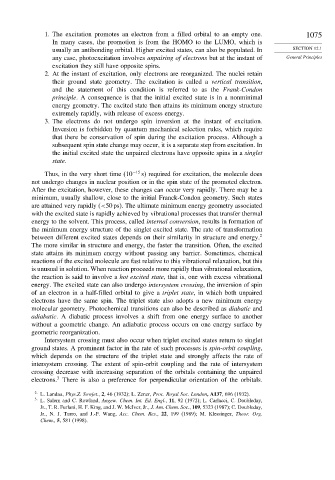Page 1090 - Advanced Organic Chemistry Part A - Structure and Mechanisms, 5th ed (2007) - Carey _ Sundberg
P. 1090
1. The excitation promotes an electron from a filled orbital to an empty one. 1075
In many cases, the promotion is from the HOMO to the LUMO, which is
usually an antibonding orbital. Higher excited states, can also be populated. In SECTION 12.1
any case, photoexcitation involves unpairing of electrons but at the instant of General Principles
excitation they still have opposite spins.
2. At the instant of excitation, only electrons are reorganized. The nuclei retain
their ground state geometry. The excitation is called a vertical transition,
and the statement of this condition is referred to as the Frank-Condon
principle. A consequence is that the initial excited state is in a nonminimal
energy geometry. The excited state then attains its minimum energy structure
extremely rapidly, with release of excess energy.
3. The electrons do not undergo spin inversion at the instant of excitation.
Inversion is forbidden by quantum mechanical selection rules, which require
that there be conservation of spin during the excitation process. Although a
subsequent spin state change may occur, it is a separate step from excitation. In
the initial excited state the unpaired electrons have opposite spins in a singlet
state.
Thus, in the very short time (10 −15 s) required for excitation, the molecule does
not undergo changes in nuclear position or in the spin state of the promoted electron.
After the excitation, however, these changes can occur very rapidly. There may be a
minimum, usually shallow, close to the initial Franck-Condon geometry. Such states
are attained very rapidly (<50 ps). The ultimate minimum energy geometry associated
with the excited state is rapidly achieved by vibrational processes that transfer thermal
energy to the solvent. This process, called internal conversion, results in formation of
the minimum energy structure of the singlet excited state. The rate of transformation
between different excited states depends on their similarity in structure and energy. 2
The more similar in structure and energy, the faster the transition. Often, the excited
state attains its minimum energy without passing any barrier. Sometimes, chemical
reactions of the excited molecule are fast relative to this vibrational relaxation, but this
is unusual in solution. When reaction proceeds more rapidly than vibrational relaxation,
the reaction is said to involve a hot excited state, that is, one with excess vibrational
energy. The excited state can also undergo intersystem crossing, the inversion of spin
of an electron in a half-filled orbital to give a triplet state, in which both unpaired
electrons have the same spin. The triplet state also adopts a new minimum energy
molecular geometry. Photochemical transitions can also be described as diabatic and
adiabatic. A diabatic process involves a shift from one energy surface to another
without a geometric change. An adiabatic process occurs on one energy surface by
geometric reorganization.
Intersystem crossing must also occur when triplet excited states return to singlet
ground states. A prominent factor in the rate of such processes is spin-orbit coupling,
which depends on the structure of the triplet state and strongly affects the rate of
intersystem crossing. The extent of spin-orbit coupling and the rate of intersystem
crossing decrease with increasing separation of the orbitals containing the unpaired
3
electrons. There is also a preference for perpendicular orientation of the orbitals.
2 L. Landau, Phys.Z. Sowjet., 2, 46 (1932); L. Zener, Proc. Royal Soc. London, A137, 696 (1932).
3
L. Salem and C. Rowland, Angew. Chem. Int. Ed. Engl., 11, 92 (1972); L. Carlacci, C. Doubleday,
Jr., T. R. Furlani, H. F. King, and J. W. McIver, Jr., J. Am. Chem. Soc., 109, 5323 (1987); C. Doubleday,
Jr., N. J. Turro, and J.-F. Wang, Acc. Chem. Res., 22, 199 (1989); M. Klessinger, Theor. Org.
Chem., 5, 581 (1998).

